A quick and dirty guide to owning a better set of kitchen cutting tools.
High-quality, sharp kitchen knives will upgrade your home cooking more than any other tool you own. And while it might seem easy to pick up a generic knife block from the nearest home furnishings store, our experts recommend curating your collection instead.
Laura and Jonny Sumner, owners of Mountain Crest Sharpening in Genoa, worked in the culinary and cooking world — including sushi shops — for years before opening their custom knife-restoration-and-sharpening business. They were kind enough to slice through some knife confusion for us.
Which Knives Do I Need?
Here are the six main knives Jonny recommends all households own, including a few for those where a lot of meat is prepared. For metal, he recommends 440 stainless steel to avoid rust and corrosion and to maintain a strong edge for a long life span.
- Versatile and utilitarian
Use a paring knife to shuck shellfish, peel fruit, and chop small vegetables and snacks. Look for a 3- to 5-inch knife with a full-sized handle for good grip and balance.
- The go-to
Look for a chef’s knife that’s 8 to 9 inches long with a good curve that allows for rocking the blade up and down for chopping. Jonny recommends trying out the rocking action in a store before purchasing. You want to be able to lift it up toward the tip and slide vegetables forward underneath it safely, then rock the blade back down without losing control.
- More than for loaves
A serrated bread knife can cut through tough-skinned vegetables, such as tomatoes, and, of course, crusty bread, melons, squashes, and others with heavy rinds. Some bread knives can carve meat, too, depending on the length.
- Not quite a knife
Use kitchen shears to cut through bones, joints, skin, thick vegetables, and flower stems. Try the handle before purchasing to ensure it fits your hand and doesn’t pinch your fingers.
- The carnivore’s choice
Find yourself making turkey, ham, and big fish often? A straight-edged carving knife has the length and articulation to cut through these large animals and navigate bones where the other blades struggle.
- Bonus for bulk buyers
Serious home chefs who purchase their meat in bulk and butcher it at home will want a cleaver to cut down the workload. A heavier cleaver with a thick spine and broad blade will do the work for you. It’s perfect for chopping through bones and thick red meat.
How To Maintain Your Kitchen Knives
Despite knives’ straight edges, sharpening them isn’t always straightforward, due to edge types and blade angles, Jonny explains. He doesn’t recommend sharpening at home without having the right tool for the job and knowing how to maintain those angles in detail.
“You don’t want to just grab a Henckels sharpener for your fancy Japanese knives,” he says. “You want to get them hand sharpened because these premium blades are made by a knife master, one at a time.”
At Mountain Crest Sharpening, the Sumners spend a lot of time restoring manufacturers’ edges damaged by improper sharpening. Sumner recommends taking knives in for professional sharpening every six to eight weeks if you cook frequently, or three to six months for the average household.
Finally, Sumner recommends hand washing and drying all knives. Some, such as Cutco brand, boast dishwasher-safe knives with resin handles, but even with those, he says, the hot-cold cycle can damage handles. Knives shoved into plastic cutlery racks or left rattling around with other dishes can end up with scratches or dinged edges, too. Wooden handles should never be washed in a dishwasher.
For similar reasons, Sumner doesn’t recommend knife blocks because they make it too easy to damage the tip or dull the edge. He says the best post-wash storage is either on magnetic strips, in a foldable soft case, or in a specialized knife drawer that lets the blades float. Some knife companies offer custom-molded sheaths to protect knives inside drawers.
With proper care and professional sharpening, a set of high-quality knives can last a long time and, more importantly, keep you safe and happy in the kitchen.
Mike Higdon is the chief storytelling officer at Flanz Media, a local storytelling and strategy agency. He used to sell Cutco knives in college and learned about full tang, surgical steel, and cutting pennies into corkscrew shapes; now he owns a set himself and needs to sharpen them more often.
Sharpen Your Tools
To learn more about Mountain Crest Sharpening’s mail-in, curbside, or drop-off sharpening services for all cutlery, shears, appliances, power tools, and barber tools, visit Mountaincrestsharpening.com. Or you can email the Sumners at Mountaincrestsharpening@gmail.com or call 775-235-2574 to set up your service.


